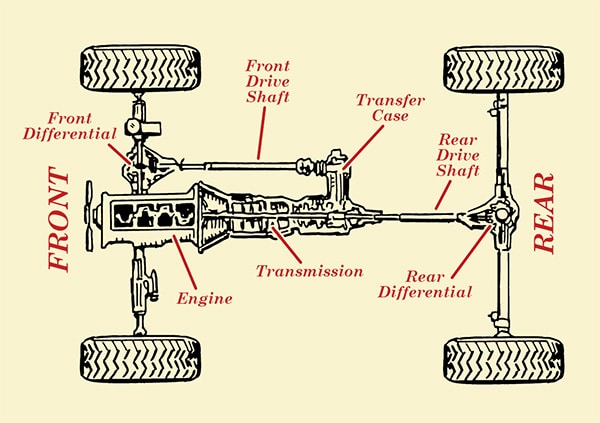Welcome back to Gearhead 101 — a series on the basics of how cars work for the automotive neophytes out there.
In our last primer, we discussed the basics of the drivetrain. The drivetrain consists of a series of parts that transfer the rotational power produced by the car’s engine to the car’s wheels to make the vehicle move. On most cars, known as two-wheel drive (2WD) cars, the drivetrain transfers power to just two wheels — either the two rear wheels (aka, rear-wheel drive) or the two front wheels (aka front-wheel drive). The movement of these two wheels makes the car move, and the other wheels in turn.
For most vehicles and in most driving conditions, having just two wheels to move your car is all you need. But when your driving surface is covered in snow or consists of loose sand and gravel, it helps to have all the wheels working together to give your car extra traction and move it over the terrain.
Enter four-wheel drive. 4WD for short.
4WD is a type of drivetrain system that, as the name implies, transfers engine power to all four wheels. You see 4WD primarily on trucks and SUVs.
While you’ve probably heard about 4WD plenty of times, and have a hazy idea of what it does for your car, there’s a good chance you don’t really know what it means or how it functions. So in today’s Gearhead 101, we’ll discuss the basics of the 4WD drivetrain system including its benefits and how it works. Our focus for this article will be part-time 4WD because it’s the most common type of 4WD you see out there. We’ll take a look at full-time 4WD next time.
This can be pretty tricky to understand. So shift your brain to 4WD and let’s get started.
Why 4WD Comes in Handy: Traction and Power
Before we get into in the specifics of how 4WD works, we need to understand why you’d want the engine powering all four wheels on your car in the first place.
Traction
As we discussed in our Gearhead 101 installment on how a car engine works, your engine produces rotational power called torque. The drivetrain (consisting of the transmission, drive shaft, and differential) transfers the engine’s torque to the wheels. Applying torque to the wheels is what makes your car go.
But to get the torque that’s been transferred to the wheels to actually move the vehicle, your tires need to have traction on the road. Without tire traction, you can apply as much power as you want to your wheels and still go nowhere. Your tires will just spin really fast while your car stays in the same place. This ineffectual tire rotation is called wheel spin. You’ve probably experienced wheel spin when trying to get your car unstuck from the snow or mud.
So traction is what transforms engine torque into vehicle movement. Yes, this is extremely simplified (we could go into the details of friction’s role in traction, but won’t), but this is a good working definition.
What 4WD does is increases the chance you can get traction when you’re driving on dicey surfaces. Instead of relying on only two powered wheels for traction (2WD), you’ve got four moving wheels that could possibly hit good traction to keep the car moving.
For example, let’s say you’re in a rear-driven 2WD vehicle and the rear wheels are in some mud while the front wheels are on dry ground. Because there’s less traction in mud, your rear wheels are likely to just spin and spin while your car stays stationary. It’d be nice to have those front wheels turning, coefficient, because that’s where the traction is.
That’s what 4WD drive does.
If you’re in a 4WD vehicle in the same situation, the front wheels that are on the high traction surface will be getting power from the engine and thus be able to propel your car forward.
4WD traction is a bit more complicated than what I just described above, and we’ll get into some of those nuances below, but the big take-away is that overall increased traction is a major benefit of 4WD.
Power
Increased power is another benefit.
If you’re off-roading up a steep hill or trying to drive over obstacles (like you see in this video), you’ll not only want more traction, but also more power sent to your wheels. 4WD can provide it.
Most 4WD vehicles offer the ability to switch between two ranges of 4WD: Hi or Lo. 4WD-Hi allows your vehicle to power all four wheels while going fast over dicey terrain — like a gravel or a snow-covered road. There’s just less power sent to the wheels.
If you need more oomph to get over an obstacle, you’ll shift to 4WD-Lo. It gives your wheels more power, but moves the wheels at a slower speed allowing you to conquer that roadblock just by driving over it.
Now that we know why 4WD would come in handy, let’s get into the nitty-gritty of how it works.
How Part-time 4WD Works
Part-time 4WD is a vehicular system that allows the driver to turn on the 4WD only when needed. On regular driving surfaces without the 4WD engaged, it works just like a rear-driven 2WD vehicle. One of the big benefits of part-time 4WD vehicles is increased fuel economy. Powering all four wheels requires more fuel than just powering two. So you can save some money on gas by only using 4WD when you need it.
Parts in Part-time 4WD
To get the front and rear wheels moving at the same time when 4WD is engaged, part-time 4WD vehicles utilize a transfer case, a separate front drive shaft (in addition to the rear drive shaft), a front and rear differential, and locking hubs. Let’s take a look at these different parts one by one.
Transfer Case
Without a transfer case, your part-time 4WD vehicle would be a 2WD vehicle.
The transfer case (also called the T-case) is what splits power from the engine 50/50 to both the rear and front axles by way of the front and rear drive shafts. The transfer usually sits right behind the transmission in your drivetrain.

Red indicates power flow from engine
In part-time 4WD vehicles, when 4WD is not engaged, the rear wheels get 100% of the torque from the engine, just like a 2WD vehicle. The power flow in this scenario looks something like this: Power produced by engine goes to the transmission. From there it goes to an output shaft and then to the transfer case. Inside the transfer case, the output shaft is connected to the rear drive shaft. The rear-drive shaft then transmits the torque to the rear differential. The rear differential then spins the wheels causing the car to move.
Alright. So how does the transfer case transfer power to the front wheels when 4WD is engaged?
Inside the transfer case there’s a series of gears and chains. When 4WD is engaged, the gears mesh together causing a chain to move a gear that’s connected to the front drive shaft. The front drive shaft starts spinning at the same speed as the rear drive shaft and delivers torque to the front differential, which then transmits torque to the front wheels. Boom. 4WD.
If you’re still a bit confused, this diagram will give you a big picture understanding of the transfer case’s role in delivering engine torque to both the front and rear axles.

In addition to the gears that sync the front and rear drive shafts, transfer cases on most part-time 4WD systems have gear sets that allow the vehicle to shift to a low range when in 4WD. As mentioned earlier, this allows the vehicle to deliver extra torque (power) to both the front and the rear wheels. You get that extra power at the cost of speed, though. When in 4WD Lo, your vehicle can only go up to 15 mph.
Front Drive Shaft
Because 4WD vehicles also send engine power to the front wheels, it needs a front drive shaft to do so. The front drive shaft connects the transfer case to the front differential. When 4WD is engaged, the transfer case splits the torque 50/50 between the front and rear drive shafts. The front drive shaft spins at the same speed as the rear drive shaft, transferring torque to the front differential. The front differential then transfers that power to the front wheels by way of the axle shafts.
Differentials
We talked about differentials in our article on the basics of the drivetrain. On 2WD vehicles, a single differential sits in the middle of the front or rear axles (depending on if the car is front- or rear-wheel drive). Power from the drive shaft is transferred through the differential to each wheel, causing them to turn. On a 4WD vehicle, because all four wheels are getting power, it needs two differentials — one for the front axle and one for the rear axle.
But the differential isn’t just a power transmitter. The reason it’s called a “differential†is that the gears inside of it allow the wheels on a single axle to move at different speeds. You’re probably thinking, “When would my wheels move at different speeds?†Well, a common instance is whenever you go around a corner. When you make a right turn, your inside wheel (the right wheel) travels less of a distance than your outside wheel (left wheel). To keep up with the inside wheel, the outside wheel must spin slightly faster. The differential makes this possible. If there was a solid connection between both wheels, the inside tire would need to skid or skip in order for the axle to keep moving. For a video demonstration of how a differential works, watch this:
The front and rear differentials on a 4WD vehicle allow the right and left wheels on each respective axle to move at different speeds so the car avoids wheel skipping or skidding when making a turn.
That seems easy enough, but differentials on a part-time 4WD vehicles can get surprisingly complex depending on how much traction you want. What’s more, if wheels are turning at different speeds (thanks to the differentials), it’s actually not true 4WD. Yeah, I know it’s confusing. We’ll clear it up here in a bit.
But, first, let’s talk about the last component that makes 4WD possible: locking hubs.
Locking Hubs
On your 2WD vehicle, the rear wheels of your car are bolted to a hub. This allows the axle to spin the wheels when powered by the engine. The front wheels just spin freely.
But when the 4WD is engaged on a part-time 4WD vehicle, we want the front wheels connected to the hub so that power from the engine can be transferred to them. How do you solve this problem of needing the front wheels bolted to the front axle when in 4WD, but not bolted when you’re in 2WD?
Locking hubs.
Most part-time 4WD vehicles have locking hubs on the front wheels. When the 4WD is not engaged, the locking hubs disconnect the axle. They spin freely, and the rear wheels of the car do all the work of moving the vehicle. When 4WD is engaged, the locking hubs lock in the front wheels to the front axle allowing them to get torque from the engine.
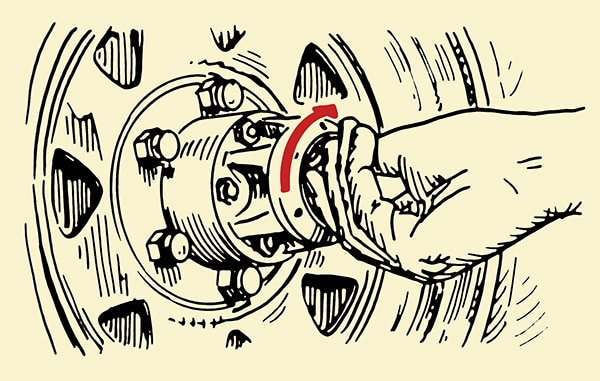
Manual locking hub
On older 4WD vehicles, manual locking hubs were standard. You’d have to get out of your vehicle and turn a knob on the front wheels until the hubs were locked. On newer 4WD vehicles, locking hubs engage automatically with the press of a button.
Differentials, Power Flow, and Traction
Alrighty, let’s circle back to the issue I brought up earlier related to 4WD differentials and traction, and why having wheels spin at different speeds on a 4WD vehicle isn’t true 4WD.
Remember, the main benefit of 4WD is increased traction on low-traction surfaces. You’ve got more wheels delivering power against the road, which increases the chances a wheel will hit a high-traction spot and keep the car moving.
But the way the most common type of differential used in vehicles (the open differential) operates can completely eliminate the traction enhancing capabilities of 4WD even if all four wheels are getting power from the engine. Let’s take a look at this problem, as well the possible solutions.
The Problem of Open Differentials on 4WD Vehicles
Open differentials are great in normal driving conditions. But because of the way in which they split power between two wheels, they become a problem in low traction driving conditions. You see, instead of splitting power evenly between both wheels, an open differential distributes power across them following a path of least resistance. This is terrible for traction.
Why?
Let’s explore this on a 2WD vehicle because you’ve likely experienced it.
Let’s say you’re trying to drive your rear-driven 2WD car up your snowy driveway. The left side is covered with snow, but the right side is dry pavement. You’d think this wouldn’t be a problem because your right rear wheel has plenty of traction on the dry pavement to power the car forward. But you’d be wrong.
In a car with an open differential, your right rear wheel isn’t going to get any power. Remember, open differentials distribute power across the axle following the path of least resistance. And in this situation, the wheel with the least resistance is the wheel driving on the snow — the left wheel. So all the torque is going to be sent to your left wheel. But because there’s no traction there, it just spins and spins, while leaving your car stationary.
This same thing happens on 4WD vehicles that utilize open differentials on the front and rear axles. Let’s use the same snowy driveway scenario. You’ve got 4WD engaged so you can make it up the snowy driveway. The transfer case is sending an equal amount of power to the front and rear differentials. You think to yourself “That snow on the left side shouldn’t be a problem at all! I’ve got plenty of traction on the right side and I’ve got both right wheels moving!â€
But the differentials on your 4WD are open differentials. And open differentials distribute power across the axle following the path of least resistance. The snow-covered left side has the least amount of resistance. Guess what happens?
All the power goes to the left wheels, causing them to spin in place while your right wheels just sit there like a bunch of lugs leaving your vehicle at the bottom of the driveway. Your 4WD was made impotent by your open differentials.
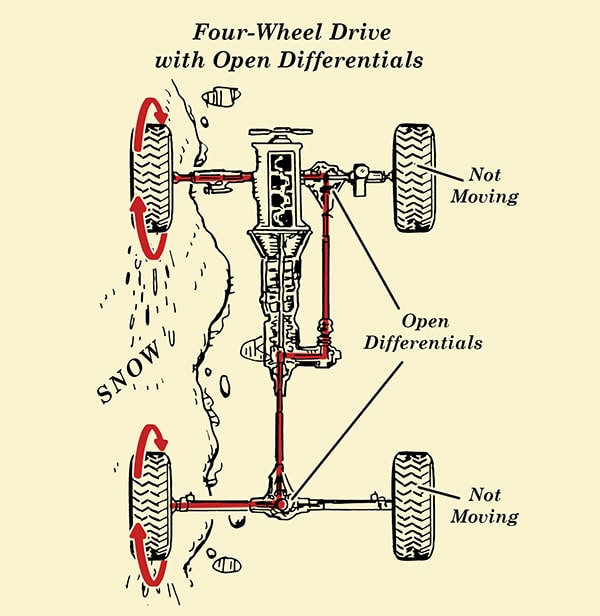
Never fear. There are solutions to this problem. One is to replace the open differentials with limited slip differentials. The second is to replace the open differential with a locking differential on the front or rear axle (or for even more traction, both).
Let’s take a look at each of these solutions.
Limited Slip Differentials
Limited slip differentials (LSDs) work a lot like open differentials. The difference is instead of sending all the torque to the wheel with the least amount of traction (like with open differentials), LSDs send some of the power to the wheel that actually has traction. It does this automatically, without any input from the driver.
So let’s revisit our snowy driveway scenario, now with LSDs on both the front and rear axles. You’ve got the 4WD engaged. The transfer case is sending an equal amount of power to the front and rear LSDs. The left wheels hit the snowy part. Instead of all the power going to the left side — like would happen if you had open differentials — the LSDs send some of the power to the right wheels that have more traction, allowing your car to move forward.
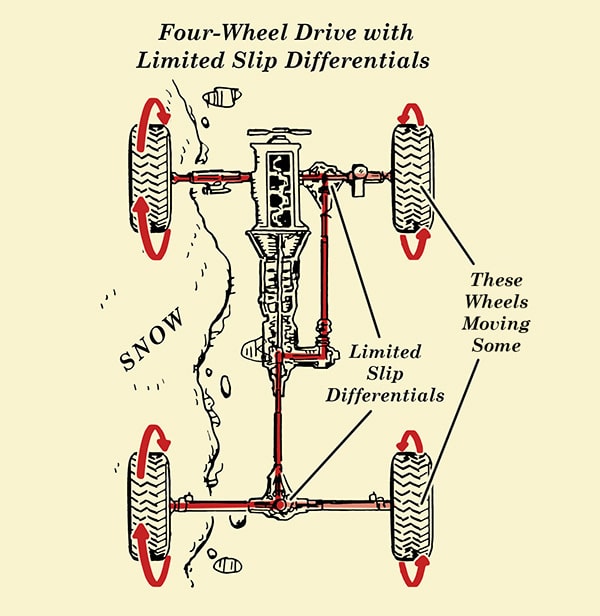
Limited slip differentials definitely improve traction compared to open differentials. For most 4WD scenarios, LSDs are all you need for adequate traction. But LSDs still don’t provide optimal traction because some of the power is still going to the wheels with less traction. There’s still a chance of wheel slip.
The other downside of LSD is that traction is unpredictable with them. The LSD sends power to the wheel with less traction, but the power isn’t supplied continuously. It’s re-routed to the other wheel as the gripping wheel begins to slip. This can cause the vehicle to pull to one side when traction is reduced. Basically, it can cause a bumpy and uneven ride.
Locking Differentials and True 4WD
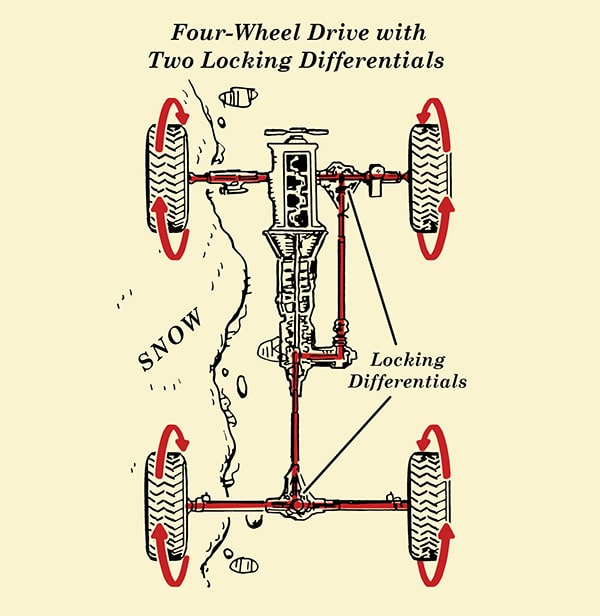
Locking differentials takes things to another level by forcing each wheel on an axle to get the same amount of power, no matter the traction differences on each wheel. This gives a wheel that may have more traction a better chance of moving the car in a low traction situation.
Locking differentials are usually driver engaged, but there are 4WD vehicles that have auto-locking differentials.
Depending on the vehicle, a locking differential can be just on the rear axle with an open or limited slip differential on the front or you could have locking differentials on both the front and rear axles.
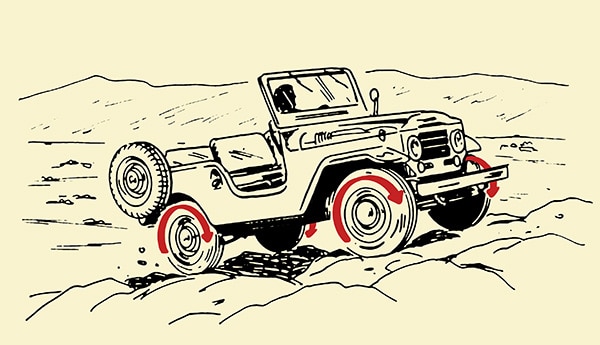
A 4WD vehicle that has two locking differentials provides true 4WD — all four wheels turn with the same amount of power no matter the situation. Even if the wheels on one side of your vehicle are completely off the ground, the wheels that are still on the ground will still continue to get a steady amount of torque.
Dual locking differentials are typically only used on 4WD vehicles that do extreme off-roading like driving over boulders and what not. For most average folks, just having 4WD that has LSDs on both the front and rear axles or a rear-locking differential with a front LSD will be enough.
This video gives great examples of what traction on a 4WD looks like with open differentials, limited slip differentials, and locking differentials:
Driving With 4WD: Possible Pitfalls
Driving with 4WD takes some know-how. It should only be used when you’re facing low-traction driving situations. If you use it when traction is great (like on dry pavement), your overland adventure will be cut short by a detour to the mechanic.
To understand why this is so, you need to understand the battle that’s going on between the left and right wheels as well as between the front and rear wheels when making a turn.
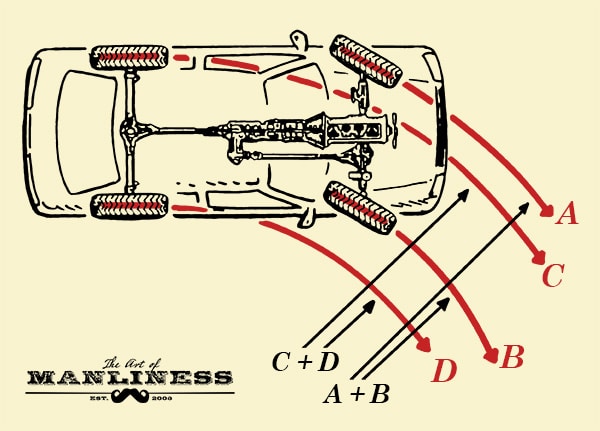
When a car turns, each wheel has to travel a different distance to make the turn.
Outside vs Inside Wheels
As we discussed earlier, when a car is making a turn, the outside wheel has to go further than the inside wheel. To keep up with the inside wheel, the outside wheel must spin slightly faster. The open and limited slip differential makes this possible.
However, if the two wheels were locked and moving at the same speed together (like what happens when you engage a locking differential), the inside tire would need to skid or skip in order for the axle to keep moving. This isn’t a problem on dirt or snow covered roads. There’s less traction in these driving situations, so tires can slide without experiencing too much wear or tear.
It becomes a problem when you try to make a similar turn on dry pavement with the differential locked. Remember, the outside wheel wants to go fast to keep up with the inside wheel, but because it’s locked with the inside wheel, it can’t. To keep up, it has to skid, but because there’s a lot of traction on pavement, this skidding chews the crap out of your outside tire. That hard skidding on pavement also places a great deal of stress on your axle shafts.
So 4WD driving takeaway #1: If your 4WD vehicle has an option to lock one or both of your differentials, never do it on dry pavement. You’ll just wear out your tires and possibly damage your axles.
Front Wheels vs Rear Wheels
When you’re making a turn, there’s also a battle going on between your front and rear wheels. The wheels on the front axle have to travel a longer distance than the rear wheels. To keep up with the rear wheels during a turn, the front wheels must spin slightly faster. If they don’t, the rear wheels will need to be able to skid and slide in order for the axle shafts to keep moving.
This isn’t a problem with 2WD vehicles because the non-driving axle allows the front wheels to freely spin faster than the rear wheels. Turning becomes a problem when you engage 4WD.
As you recall, when you engage 4WD, the transfer case locks the front and rear drive shafts together. They send the same amount of power, or RPM, to the front and rear differentials. Forcing the front and rear drivetrains to work together like this creates a battle between the two when you’re making a turn with 4WD engaged. The front wheels need to go faster to keep up with the rear wheels, but the transfer case and front drive shaft are telling the front wheels to go the same speed as the rear wheels. This creates tension between them.
One way to relieve this tension is to let the rear tires slip and slide a bit. And that’s what happens in low traction situations like dirt or snow because they provide the needed “give†to allow your front wheels to slip and slide when making a turn.
But when your 4WD vehicle is making a turn on dry pavement with lots of traction, that “give†doesn’t exist. The tires can’t slip and slide. So this creates a tug-of-war between the front wheels and the front drivetrain. When making a turn the front wheels are forced by good traction and geometry to rotate faster than the rear wheels. But the front drive shaft is delivering the same RPM as the rear drive shaft is to the rear wheels. The front drive shaft is basically telling the front wheels “Hey! Go the same speed as everyone else!†while the front wheels themselves are saying “Nope!â€
Imagine a bar that’s connected to a rotating gear at each end. The gears spin the bar in the same direction, but one end is spinning it at a faster speed than the other. That’s basically what’s happening between your wheels and front driveshaft.
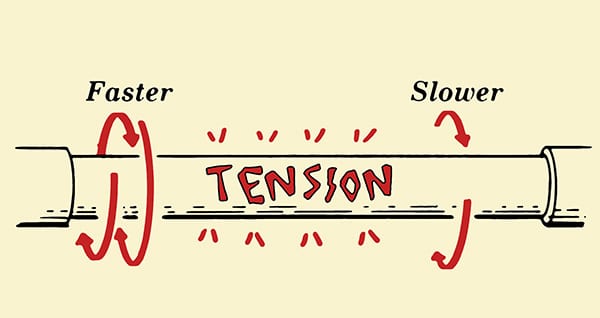
A visual of what happens to your front drivetrain whenever you make a turn on pavement with the 4WD engaged.
This battle between the front wheels and the front drive shaft stresses all the parts on the front drive train, from the axles to the transfer case. Gears along the front drivetrain and in the transfer case start binding and jamming together. This is called “drivetrain binding†or “wind-up†and it can seriously jack up your 4WD drivetrain.
You’ll know you’ve got a case of drivetrain binding if the car is jerking around a lot when you’re driving, and if it’s impossible to disengage the 4WD and shift back to 2WD. You can sometimes “unwind†your drivetrain wind-up by slowly driving backwards, but it doesn’t work all the time. If you made a particularly fast turn in 4WD on dry pavement, the tension it causes can cause the weakest links in your front drive train to break — u-joints, differential gears, transfer case gears, drive shafts, etc.
Lest you think you can get away with driving in 4WD on pavement, but just go straight, take heed. Different tire pressures on your wheels can also cause this wind-up even when driving straight on pavement in 4WD. Take a look at what happened to this guy’s transfer case after accidently driving straight in 4WD on the freeway.
So 4WD driving takeaway #2: Never engage your 4WD on dry pavement. You’ll just jack-up your drivetrain.
Well, there you go. A primer on how part-time 4WD works. I hope it was helpful. Even if you never purchase a 4WD vehicle, you’ll at least know what people are talking about next time 4x4s come up in conversation. In our next edition of Gearhead 101, we take a look at how full-time 4WD, as well as AWD, works.
Tags: Cars


